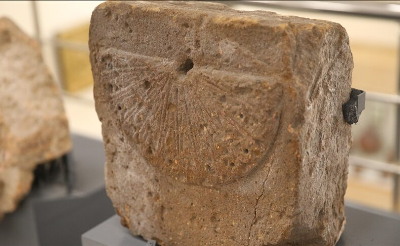
© www.anatolianarchaeology.net/
У Туреччині, на території середньовічного міста Ані — об'єкта Світової спадщини ЮНЕСКО, вперше представили публіці унікальний артефакт: сонячний годинник, вік якого становить приблизно тисячу років. Знахідку виявили під час розкопок у 2021 році у районі стародавнього хамаму. Тепер артефакт експонується у музеї Карса та вже викликає жвавий інтерес у туристів. Стародавнє місто Ані, розташоване на сході Туреччини, відоме своєю багатою історією та унікальною архітектурною спадщиною. У різні періоди воно було осередком 23 цивілізацій і містить численні пам’ятки — від мечетей і храмів до палаців, монастирів і мостів. Значна частина міста — близько 1500 підземних приміщень — досі частково збереглася. Представлений сонячний годинник має півколову форму з дванадцятьма сегментами та металевим стрижнем у центрі, який відкидає тінь залежно від положення сонця. За словами науковців, подібні годинники були поширені ще в античності, але у середньовіччі такі технології майже не розвивалися, тому ця знахідка має особливу цінність для істориків науки. Артефакт став частиною національної музейної ініціативи «100+2», покликаної привернути увагу до археологічної спадщини Туреччини. За словами дослідників, годинник дає змогу не лише глибше зрозуміти побут і знання людей того часу, а й нагадує про роль Ані як важливого культурного й наукового центру свого періоду.
A 1,000-Year-Old Sundial Unveiled in the Ancient City of Ani
In Turkey, a unique artifact—a sundial estimated to be around 1,000 years old—has been unveiled to the public for the first time at the medieval site of Ani, a UNESCO World Heritage Site. The discovery was made in 2021 during excavations in the area of an ancient bathhouse. Now housed in the Kars Museum, the sundial is already drawing significant interest from both domestic and international tourists. The ancient city of Ani, located in eastern Turkey, is renowned for its rich history and distinctive architectural heritage. Throughout its existence, it served as the home of 23 different civilizations and features numerous historical monuments, including mosques, churches, cathedrals, palaces, monasteries, and bridges. Remarkably, the site still preserves around 1,500 underground structures. The newly presented sundial features a semicircular shape divided into twelve segments, with a central metal rod casting a shadow to indicate the time based on the sun’s position. According to Hakim Aslan, Acting Director of the Kars Archaeological and Ethnographic Museum, such timekeeping instruments were common in antiquity, particularly in Roman and Hellenistic periods. However, technological development in sundials saw a decline during the Middle Ages, making this medieval specimen especially valuable to the history of science. The artifact is now part of Turkey’s national museum initiative “100+2,” aimed at highlighting the country’s archaeological heritage. Researchers note that the sundial not only offers insight into the daily life and scientific knowledge of its time but also reaffirms Ani’s status as a major cultural and intellectual center of the medieval era.
1089